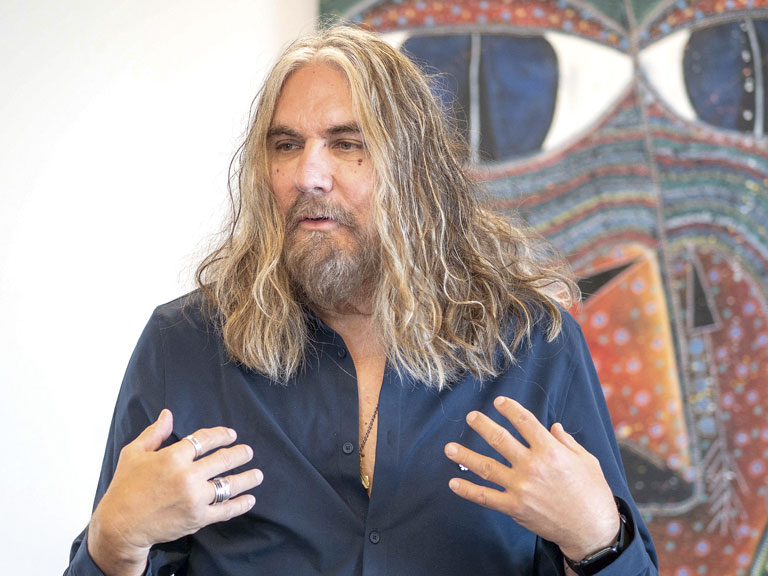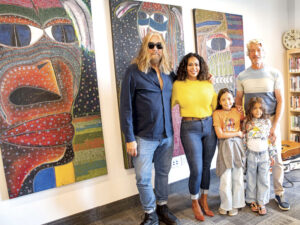County News
Warrior Trilogy

Triptych by Tom Wilson on longterm loan to Picton Library
Candace Singh and Patrick Kilduff were instantly enthralled by Tom Wilson’s Warrior Trilogy triptych when they saw it at Hatch Gallery on opening night of his exhibit. They purchased the artwork, and soon realized the piece needed to have a larger audience for its impact to be truly felt. After a months-long process—partly due to obtaining adequate insurance—the paintings were unveiled last Wednesday at the Picton Library in an event timed to coincide with the Indigenaction film festival at the Regent Theatre and coming a few days before the National Day for Truth and Reconciliation.

Artist Tom Wilson (L) stands with the Singh-Kilduff family (L-R): Candace, Adara, Ireland and Patrick, in front of his triptych at the Picton Library.
Tom Wilson is a Juno award-winning musician playing with bands such as Blackie and the Rodeo Kings and Lee Harvey Osmond. He grew up in Hamilton, and until 10 years ago he believed he was of Irish heritage. In fact, he was one of the “Sixties Scoop” children, and his birth parents were Mohawks from Kahnawake; the woman he knew as “Cousin Janey” was actually his mother. He started painting in 1997 as a way to break his addiction to alcohol, and he has remained sober for the past 24 years. He said his paintings came from within him, and unknown to him at the time, he said it was an expression of his Indigenous ancestry striving to get out. It was only after his birth mother told him the true story while he was driving her back to Montreal that the pieces finally fell into place. He has continued to produce art in his unique style, incorporating his words into his images. In 2017, he released his book Beautiful Scars, which tells of his awakening to his Indigenous heritage. The book has been made into a film, which was screened at the Regent Theatre on September 26. A stage play is currently under development.
Last Wednesday, Dave Hatch of Hatch Gallery and Tom Wilson unveiled Warrior Trilogy at the Picton Library. Mr. Wilson said he was honoured to have the artwork displayed in public, and he sees his art as a way to tell the story of his Indigenous culture. “I am blessed and happy that this painting is on display here. We’ve been gifted the opportunity to start a conversation, and it’s our responsibility to keep the conversation going. My work for the past 10 years has been dedicated to bringing the Mohawk culture into the light. I don’t try to tell anyone else’s story but my own. In all of these things I’ve been doing, I’m leading with art.”
“The way we are going to move forward, not only as a community, but as a country, is that it’s up to us to open our hearts and show gratitude for everything that we have, give love and respect and patience to everyone we meet in order to make this a better planet. The story of the Indigenous world needs to continue to be told in ways that bring people to the table,” he said. The scars of the past inhumane treatment of Indigenous peoples by the Canadian government are still evident today, and Mr. Wilson cites the lack of clean water on Reserves, the fight to honour broken treaties and the lack of accountability when it comes to murdered and missing Indigenous women among the many areas that need to be addressed. “I want to create a world where you don’t need the word ‘reconciliation’,” he said.
Candace Singh said that her family was thrilled that the artwork will be on display at the library. She really became aware of what had been happening in Indigenous communities after the discovery of 215 unmarked graves at a residential school in Kamloops in 2021. “I’ve always been very passionate about equity and diversity and racial issues, and when this came to light it really propelled me to add to that discussion. When we saw Tom’s work, we knew that we would love to do something and have this available for the greater community,” she said.
Library CEO Barbara Sweet thanked Tom Wilson for the artwork, and she thanked the Singh-Kilduff family for their generosity in allowing the triptych to be displayed in the library. Councillor Corey Engelsdorfer expressed his thanks on behalf of Shire Hall and Mayor Steve Ferguson. Mr. Wilson, who was recently named to the Order of Canada, said that his body of work has now been archived at McMaster University in Hamilton, and he has created a scholarship in the name of his mother, Bunny Wilson, for Indigenous students. Several years ago he was formally accepted as a Mohawk of Kahnawake and has been given the name of Tehohàhake—meaning Two Roads to recognize his path through life. He told the story of how his birth mother attended residential school where she was told she would be the last Mohawk generation, and then recounted the last family gathering where he brought his son and grandchildren. “Four generations of Mohawks. We are survivors,” he said. To close the afternoon, he invited his son Thompson to join him in singing two songs that highlighted the determination of his people to receive fair treatment.

Comments (0)